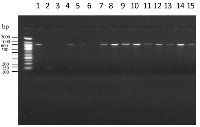Genetic assessment of Mangifera indica Linn. (Mango) from selected locations in Oyo State, Nigeria
Main Article Content
Abstract
This study characterized five (5) varieties of mango comprising 15 accessions collected from Ogbomosho, Saki, Ibadan and other locations in Oyo State. The field experiment was laid out in a Complete Randomized Design (CRD) with three replicates. Morphological characters were assessed on the stem, leaf and fruit. Also, Molecular studies (DNA amplification and sequencing) were carried out on 15 accessions of mango. The edited sequences were blasted in the National Center of Biotechnology Information (NCBI) data website. The Results showed variability in morphological characters of Mango. Ogbomosho Acc-2 performed best for leaf width (4.53cm) and lamina length (16.25cm) while Isehin Acc-1 had the highest number of leaves per seedling (7.76cm), leaf length (17.06cm), leaf area (38.84cm), petiole length (2.27cm), plant height (24.07cm) respectively. The Number of leaves had pos itive correlation with Leaf length (r=0.53), Leaf Area (r=0.59), Internodal Length (r= 0.55) and strong positive correlation with plant height (r=0.73) at p≤0.05. The success rate of amplified DNA products and sequencing was 77.78%. The query coverage of 99% and 100% confirmed positive amplification and sequencing of rbcL gene in the mango varieties. The sequences blasted in the NCBI data website were identified to be similar to accession KX871231.1. Sequences of rbcL marker showed genetic differences among samples; Grafe and OGBM Acc -1. Genetic distance between varieties from the same location was most often lower with Grafe mango being the most distant variety with genetic distance of 0.114-0.117. There were morphological and molecular variations in mango varieties and accessions. Isehin Acc-1, Saki Acc-1 and OGBM Acc-6 accessions had better growth performance.
Downloads
Article Details

This work is licensed under a Creative Commons Attribution-NonCommercial-NoDerivatives 4.0 International License.
References
Azim, M. K., Khan, I. A. and Zhang, Y. (2014). Characterization of mango (Mangifera indica L.) transcriptome and chloroplast genome. Plant Molecular Biology, 85 (1-2): 193–208.
Begum, H., Reddy, M.T, Malathi, S., Reddy, B.P, Narshimulu, G., Nagaraju, J. and Siddiq, E.A. (2014). Morphological and microsatellite analysis of intravarietal heterogeneity in Beneshan‟ Mango (Mangifera indicaL.). International Journal of Agricultural and Food Research
(2):16-33.
FAOSTAT (2015) http://faostat3.fao.org/home/index.html# VISUALIZE_TOP_20. AccessedFood and Agriculture Organization
(FAO) (2015). FAOSTAT. Food and Agriculture Organization of the United Nations, Rome, Italy. http://www.fao.org/faostat/en/#data/QC.
Fowomola, M. A. (2010). Some nutrients and antinutrients contents of mango (Magnifera indica) seed. African Journal of Food Science 4(8): 472 –476.
Goldenberger, D., Perschil, I., Ritzler, M. and Altwegg, M. (1995). A simple "universal" DNA extraction procedure using SDS and Proteinase K is compatible with direct PCR amplification. PCR Methods and Applications, 4: 368-370.
Gonzalez, A., Coulson, M. and Brettell, R. (2002). Development of DNA Markers (ISSRs) in Mango. Acta Hortic., 575: 139-143.
Hartana, F. (2010). Characterization and evaluation of Musa acuminate cultivars in Indonesia based on microsatellite markers. Floribunda
:1.
Hoogendijk, M. and Williams, D. (2001). Characterizing the genetic diversity of home garden Crops: Some examples from Americas. 2nd international home gardens workshop, 17-19 July 2001, Witzenhausen, Federal Republic of Germany. p. 34-40.
International Institute of Tropical Agriculture, IITA. (2015). Retrieved from: www.iita.org IPGRI, (2006). Descriptors for mango (Mangifera
indica). International Plant Genetic Resources Institute, Rome, Italy.Iquebal, (2017). Development of Highly Informative Genome-Wide Single Sequence Repeat Markers for Breeding Applications in Sesame and Construction of a Web Resource SisatBase Plant Sci., 22:14-
Kaur, M., Bal. J.S, Bali, S.K., Sharma, L.K. and Bali, S.K. (2014). An evaluation of mango (Mangifera indica L.) germplasm for future breeding programme. African Journal of Agricultural Research 9(20):1530-1538
Litz R.E. 2009 (ed.), The Mango, Botany, Production and Uses. CAB International, Wallingford, UK
Mukherjee, S.K. and Litz, R.E. (2009). Introduction: botany and importance. In: The mango: Botany, Production and Uses. CABI. USA pp. 1-18.
Mussane C.R.B., Biljon, A.V. and Herselman, L. 2010. Morphological and genetic characterization of mango varieties in Mozambique, Second RUFORUM Biennial Meeting 20 - 24 September 2010, Entebbe, Uganda.
Okigbo, R.W. (2001). Occurrence, pathogenicity and survival of Macrophoma mangifera in leaves, branches and stems of mango (Mangifera indica). Plant Protection Science 37: 138-144.
Olawuyi, O., Bello, O., Ntube, C. and Akanmu, A. (2015). Progress from selection of some maize cultivars response to drought in the derived savanna of Nigeria. Agrivita 37(1):8
Roy, B. and Visweswaraiya, S.S. (1995). Cytogenetics of Mango and Banana, Report. Maharashtra Association for the Cultivation of Sciences, Pune.
Rymbai, H., Laxman, R.H., Dinesh, M.R., Sunoj, V.S.J., Ravishankar, K.V. and Jha, A.K (2014). Diversity in leafmorphology and physiological
characteristics among mango (Mangifera indica) cultivars popular in `different agro-climatic regions of India. Scientia Horticulture 176:189-193.
Sánchez-Guillén., M. Wellenreuther, R.A., Cordero-Rivera, A. Erik I. Svensson, B.H. (2011). Environmental and climatic determinants of molecular diversity and genetic population structure in a coenagrionid damselfly. PloS One, 6 (5), e20440. https://doi.org/10.1371/journal.pone.0020440
Singh, (2016). Assembly of highly heterozygous mango (Mangifera indica cv. Amrapali) genome using PacBio long sequence reads, PA 2016.
Subedi, A., Bajracharya, J., Joshi, B.K., Gupta, S.R., Regmi, H.N. and Sthapit, B. (2009). Locating and managing the mango (Mangifera indica L.) genetic resources in Nepal. PGR - News, FAO - Bioversity International, 115, 52-61.
Verheiji, E. (2004). Propagating and planting trees Agrodok-series. Agromisa/CTA.102.
Zeugin, J.A. and Hartley, J.L. (1985). Ethanol precipitation of DNA. BRL-Focus 7:1–2.


